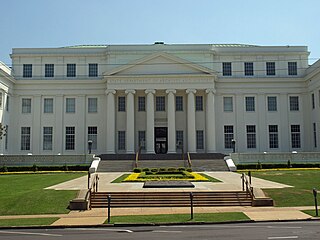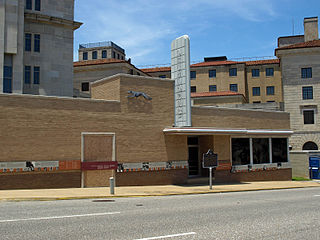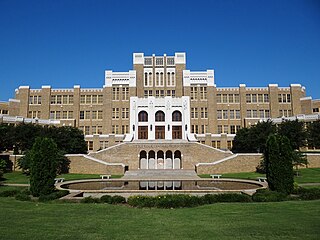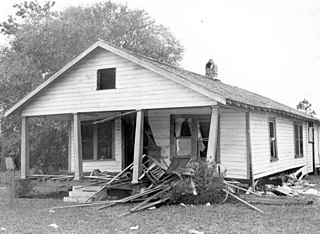 W
WThe 16th Street Baptist Church is a Baptist church in Birmingham, Alabama, United States, affiliated with the Progressive National Baptist Convention. In 1963, the church was bombed by Ku Klux Klan members. The bombing killed four young girls in the midst of the Civil Rights Movement. The church is still in operation and is a central landmark in the Birmingham Civil Rights District. It was designated as a National Historic Landmark in 2006. Since 2008, it has also been on the UNESCO list of tentative World Heritage Sites.
 W
WThe Alabama Department of Archives and History (ADAH) is the official repository of archival records for the U.S. state of Alabama. Under the direction of Thomas M. Owen its founder, the agency received state funding by an act of the Alabama Legislature on February 27, 1901. Its primary mission is the collecting and preserving of archives, documents and artifacts relating to the history of the state. It was the first publicly funded, independent state archives agency in the United States. It subsequently became a model for the establishment of archives in other states. Today the agency identifies, preserves, and makes accessible records and artifacts significant to the history of the state and serves as the official repository for records created by Alabama's state agencies.
 W
WThe Birmingham Civil Rights District is an area of downtown Birmingham, Alabama where several significant events in the Civil Rights Movement of the 1950s and 1960s took place. The district was designated by the City of Birmingham in 1992 and covers a six-block area.
 W
WBirmingham Civil Rights Institute is a large interpretive museum and research center in Birmingham, Alabama that depicts the struggles of the Civil Rights Movement in the 1950s and 1960s. The Institute is located in the Civil Rights District, which includes the historic 16th Street Baptist Church, Kelly Ingram Park, Fourth Avenue Business District, and the Alabama Jazz Hall of Fame located in the Carver Theatre. The Institute opened in November 1992, and had more than 25,000 visitors during its first week.
 W
WThe National Center for Civil and Human Rights is a museum dedicated to the achievements of both the civil rights movement in the United States and the broader worldwide human rights movement. Located in downtown Atlanta, Georgia, the museum opened to the public on June 23, 2014.
 W
WDexter Avenue Baptist Church is a Baptist church in Montgomery, Alabama, United States, affiliated with the Progressive National Baptist Convention. The church was designated as a National Historic Landmark in 1974 because of its importance in the civil rights movement and American history. In 1978 the official name was changed to the Dexter Avenue King Memorial Baptist Church, in memory of Dr. Martin Luther King Jr., who was pastor there and helped organize the Montgomery bus boycott in 1955 during the civil rights era. The church is located steps away from the Alabama State Capitol.
 W
WThe Freedom Rides Museum is located at 210 South Court Street in Montgomery, Alabama, in the building which was until 1995 the Montgomery Greyhound Bus Station. It was the site of a violent attack on participants in the 1961 Freedom Ride during the Civil Rights Movement. The May 1961 assaults, carried out by a mob of white protesters who confronted the civil rights activists, "shocked the nation and led the Kennedy Administration to side with civil rights protesters for the first time."
 W
WThe International Civil Rights Center & Museum (ICRCM) is located in Greensboro, North Carolina, United States. Its building formerly housed the Woolworth's, the site of a non-violent protest in the civil rights movement. Four students from North Carolina Agricultural and Technical State University started the Greensboro sit-ins at a "whites only" lunch counter on February 1, 1960. The four students were Franklin McCain, Joseph McNeil, Ezell Blair, Jr., and David Richmond. The next day there were twenty students. The aim of the museum's founders is to ensure that history remembers the actions of the A&T Four, those who joined them in the daily Woolworth's sit-ins, and others around the country who took part in sit-ins and in the civil rights movement. The Museum is currently supported by earned admissions and Museum Store revenues. The project also receives donations from private donors as a means of continuing its operations. The museum was founded in 1993 and officially opened its doors just fifty years to the day after the sit-in movements in Greensboro NC.
 W
WThe International Civil Rights Walk of Fame, which honors some of the activists involved in the Civil Rights Movement and others involved in civil rights activities, was created in 2004 and is located at the Martin Luther King Jr. National Historic Site in Atlanta. It consists of a promenade that showcases the footstep impressions of those honored, marked in granite and bronze. According to the National Park Service, which runs the historic site, the Walk of Fame was created "to give recognition to those courageous soldiers of justice who sacrificed and struggled to make equality a reality for all." Another motivation was to enhance the historic value of the area, enrich its cultural heritage, and make the site a better tourist attraction.
 W
WKelly Ingram Park, formerly West Park, is a 4 acres (1.6 ha) park located in Birmingham, Alabama. It is bounded by 16th and 17th Streets and 5th and 6th Avenues North in the Birmingham Civil Rights District. The park, just outside the doors of the 16th Street Baptist Church, served as a central staging ground for large-scale demonstrations during the American Civil Rights Movement of the 1960s.
 W
WThe Martin Luther King Jr. Center for Nonviolent Social Change, commonly known as The King Center, is a nongovernmental, not-for-profit organization in Atlanta, United States.
 W
WThe Legacy Museum: From Enslavement to Mass Incarceration is a museum in Montgomery, Alabama, that displays the history of slavery and racism in America. This includes the enslavement of African-Americans, racial lynchings, segregation, and racial bias.
 W
WLittle Rock Central High School (LRCHS) is an accredited comprehensive public high school in Little Rock, Arkansas, United States. The school was the site of forced desegregation in 1957 after the U.S. Supreme Court ruled that segregation of public schools was unconstitutional three years earlier. This was during the period of heightened activism in the civil rights movement.
 W
WThe Lyndon Baines Johnson Library and Museum, also known as the LBJ Presidential Library, is the presidential library and museum of Lyndon Baines Johnson, the 36th President of the United States (1963–1969). It is located on the grounds of the University of Texas at Austin, and is one of 13 Presidential Libraries administered by the National Archives and Records Administration. The LBJ Library houses 45 million pages of historical documents, including the papers of President Johnson and those of his close associates and others.
 W
WThe Martin Luther King, Jr. Memorial is located in West Potomac Park next to the National Mall in Washington, D.C., United States. It covers four acres (1.6 ha) and includes the Stone of Hope, a granite statue of Civil Rights Movement leader Martin Luther King Jr. carved by sculptor Lei Yixin. The inspiration for the memorial design is a line from King's "I Have A Dream" speech: "Out of the mountain of despair, a stone of hope." The memorial opened to the public on August 22, 2011, after more than two decades of planning, fund-raising, and construction.
 W
WThe Martin Luther King Jr. National Historical Park consists of several buildings in Atlanta, Georgia, including Martin Luther King Jr.'s boyhood home and the original Ebenezer Baptist Church, the church where King was baptized and both his father Martin Luther King Sr. and he were pastors.
 W
WThe Mississippi Civil Rights Museum is a museum in Jackson, Mississippi. Its mission is to document, exhibit the history of, and educate the public about the American Civil Rights Movement in the U.S. state of Mississippi between 1945 and 1970. The museum secured $20 million in funding from the Mississippi Legislature in April 2011 after Governor Haley Barbour testified in favor of its funding. Ground was broken in 2013, and the museum opened on December 9, 2017. The museum is administered by the Mississippi Department of Archives and History.
 W
WMoore Memorial Park and Cultural Center is a historic site in Mims, Florida. The site, which was the home of civil rights leader Harry T. Moore, now houses a museum, conference center and park.
 W
WThe National Afro-American Museum and Cultural Center is a museum located in Wilberforce, Ohio, whose mission is to chronicle through its collections and programs the rich and varied experiences of African Americans from their African origins to the present. It is one of many museums operated by the Ohio History Connection.
 W
WThe National Civil Rights Museum is a complex of museums and historic buildings in Memphis, Tennessee; its exhibits trace the history of the civil rights movement in the United States from the 17th century to the present. The museum is built around the former Lorraine Motel, which was the site of the assassination of Martin Luther King Jr. in 1968; King died at St. Joseph's Hospital. Two other buildings and their adjacent property, also connected with the King assassination, have been acquired as part of the museum complex.
 W
WThe National Museum of African American History and Culture (NMAAHC) is a Smithsonian Institution museum located on the National Mall in Washington, D.C., in the United States. It was established in December 2003 and opened its permanent home in September 2016 with a ceremony led by President Barack Obama.
 W
WThe National Voting Rights Museum and Institute, established in 1991 and opened in 1993, is an American museum in Selma, Alabama which honors, chronicles, collects, archives, and displays the artifacts and testimony of the activists who participated in the events leading up to and including the 1965 Selma to Montgomery marches, and passage of the 1965 Voting Rights Act, as well as those who worked for the African-American Voting Rights and Women's Suffrage movements. As the museum describes in its mission statement, it recognizes other people, events, and actions which furthered America's Right to Vote since "the Founding Fathers first planted the seeds of democracy in 1776." The museum was founded by Faya Ora Rose Touré and Marie Foster.
 W
WThe Robert Russa Moton Museum is a historic site and museum at 900 Griffin Boulevard in Farmville, Prince Edward County, Virginia. It is located in the former Robert Russa Moton High School, considered "the student birthplace of America's Civil Rights Movement" for its initial student strike and ultimate role in the 1954 Brown v. Board of Education case desegregating public schools. It was designated a National Historic Landmark in 1998, and is now a museum dedicated to that history. The museum were named for African-American educator Robert Russa Moton.
 W
WThe Rosa Parks Museum is located on the Troy University at Montgomery satellite campus, in Montgomery, Alabama. It has information, exhibits, and some artifacts from the 1955 Montgomery bus boycott. This museum is named after civil rights activist Rosa Parks, who is known for refusing to surrender her seat to a white person on a city bus.